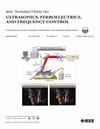Chirp-Coded Subharmonic Imaging With Volterra Filtering: Histotripsy Bubble Cloud Assessment In Vitro and Ex Vivo
IF 3.7
2区 工程技术
Q1 ACOUSTICS
IEEE transactions on ultrasonics, ferroelectrics, and frequency control
Pub Date : 2025-04-03
DOI:10.1109/TUFFC.2025.3556030
引用次数: 0
Abstract
Histotripsy is a noninvasive focused ultrasound therapy that liquifies tissue via bubble activity. Conventional ultrasound imaging is used in current clinical practice to monitor histotripsy. Developing surrogate imaging metrics for successful treatment outcomes remains an unmet clinical need. The goal of this work was twofold. First, we investigated whether histotripsy bubble clouds detected with nonlinear imaging (chirp-coded subharmonic imaging with and without Volterra filtering) could be used to assess the ablation zone in vitro. Second, we evaluated the feasibility of improving bubble cloud contrast with this approach in ex vivo porcine kidney. Histotripsy bubble clouds were generated in red blood cell-doped agarose phantoms and imaged with a curvilinear ultrasound probe. The ablation zone was assessed based on images collected with a digital camera. The relationship between the bubble cloud area and the ablation area was assessed using receiver operating characteristic (ROC) analysis, F1 score, accuracy, and Matthews correlation coefficient. Histotripsy bubble clouds were also generated in ex vivo porcine tissue and the ability to improve bubble cloud contrast to tissue was evaluated. Implementing chirp-coded subharmonic imaging with the third-order Volterra filter enhanced contrast-to-tissue ratio (CTR) by up to沃尔泰拉滤波的啁啾编码次谐波成像:体外和离体组织泡沫云评估。
组织活检是一种非侵入性聚焦超声治疗,通过气泡活动液化组织。常规超声成像在目前的临床实践中用于监测组织切片。开发替代成像指标的成功治疗结果仍然是一个未满足的临床需求。这项工作的目标是双重的。首先,我们研究了用非线性成像(带或不带Volterra滤波的啁啾编码次谐波成像)检测到的组织层状气泡云是否可以用于体外评估消融区。其次,我们评估了这种方法在离体猪肾脏中改善气泡云对比的可行性。在红细胞掺杂琼脂糖的幻影中产生了组织分层的气泡云,并用曲线超声探头成像。根据数码相机采集的图像对消融区进行评估。利用受者工作特征分析、f1评分和Intersection over Union评分评估气泡云面积与消融面积的关系。在离体猪组织中也产生了组织分层气泡云,并评估了改善气泡云与组织对比度的能力。与体外标准成像相比,使用三阶Volterra滤波器实现啁啾编码次谐波成像可使组织对比度提高40.06±0.70 dB。此外,亚谐波成像结合Volterra滤波,根据分析指标估计出与烧蚀区最匹配的气泡云区域。此外,离体研究表明,组织比提高高达26.95±6.49 dB。综上所述,这些发现促进了组织切片术的图像引导和监测方法。
本文章由计算机程序翻译,如有差异,请以英文原文为准。
求助全文
约1分钟内获得全文
求助全文
来源期刊
CiteScore
7.70
自引率
16.70%
发文量
583
审稿时长
4.5 months
期刊介绍:
IEEE Transactions on Ultrasonics, Ferroelectrics and Frequency Control includes the theory, technology, materials, and applications relating to: (1) the generation, transmission, and detection of ultrasonic waves and related phenomena; (2) medical ultrasound, including hyperthermia, bioeffects, tissue characterization and imaging; (3) ferroelectric, piezoelectric, and piezomagnetic materials, including crystals, polycrystalline solids, films, polymers, and composites; (4) frequency control, timing and time distribution, including crystal oscillators and other means of classical frequency control, and atomic, molecular and laser frequency control standards. Areas of interest range from fundamental studies to the design and/or applications of devices and systems.

 求助内容:
求助内容: 应助结果提醒方式:
应助结果提醒方式:


